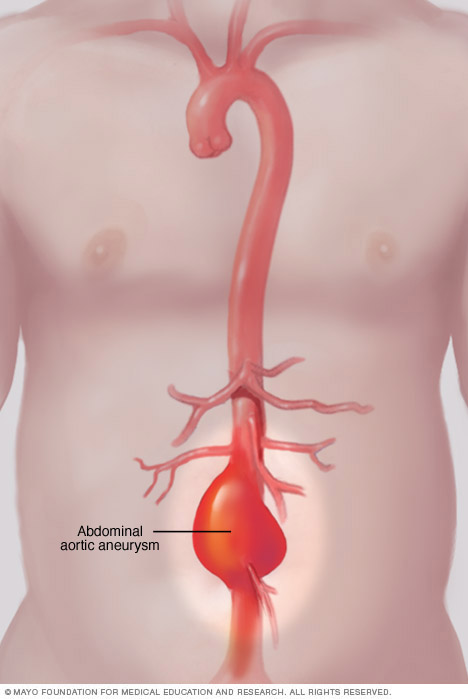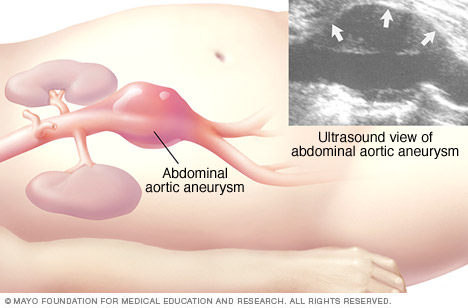Abdominal ultrasound
![]() April, 2nd, 2025
April, 2nd, 2025
Summary
An ultrasound of the abdomen is the preferred test to screen for an aortic aneurysm. But it may be done for other health reasons too. Learn why.
Overview
, Overview, ,
An abdominal ultrasound is a medical imaging test that uses sound waves to see inside the belly area, also called the abdomen. It’s the preferred screening test for abdominal aortic aneurysm. But the test may be used to diagnose or rule out many other health conditions.
An abdominal aortic aneurysm, or aortic aneurysm, is an enlarged area in the lower part of the body’s main artery, called the aorta. Healthcare professionals recommend an abdominal ultrasound to screen for aortic aneurysm in men ages 65 to 75 who smoke or used to smoke.
Such screening isn’t recommended for people who’ve never smoked. But it may be done if you have symptoms or a family history of aortic aneurysm.

An abdominal aortic aneurysm occurs when a lower part of the body’s main artery, called the aorta, gets weak and bulges outward like a balloon.

The enlarged area in the lower part of the aorta is an abdominal aortic aneurysm. An ultrasound image of an abdominal aortic aneurysm is shown in the upper right corner. Ultrasound imaging is often used to diagnose abdominal aortic aneurysms.
Abdominal ultrasound of an abdominal aortic aneurysm Why it’s done
An abdominal ultrasound is done to see the blood vessels and organs in the belly area. Your healthcare professional may suggest this test if you have a condition affecting any of these body areas:
- Blood vessels in the abdomen.
- Gallbladder.
- Intestines.
- Kidneys.
- Liver.
- Pancreas.
- Spleen.
For instance, an abdominal ultrasound can help show the cause of stomach pain or bloating. An abdominal ultrasound can check for:
- Kidney stones.
- Liver disease.
- Tumors and many other conditions.
Your healthcare professional may recommend this test if you’re at risk of an abdominal aortic aneurysm.
Screening for aortic aneurysms
An abdominal ultrasound is the most common test to screen for abdominal aortic aneurysm. Screening means looking for the condition in people without symptoms. Early diagnosis helps you and your healthcare professional take steps to manage and treat an aneurysm. If an aortic aneurysm ruptures, the bleeding can lead to death quickly.
A one-time abdominal aortic ultrasound screening is recommended for men ages 65 to 75 who have smoked at least 100 cigarettes during their lifetimes.
Screening also is recommended for men age 60 and older who have or had a parent or sibling with aortic aneurysm. It’s otherwise unclear whether men who have never smoked may benefit from such screening.
Routine ultrasound screening for abdominal aortic aneurysm isn’t recommended for women.
Risks
There are no known risks. Abdominal ultrasound is a safe, painless procedure. But you may have some brief discomfort if the healthcare professional presses on an area that is sore or tender.
How you prepare
Your healthcare professional or a member of the healthcare team in a radiology department tells you what you need to do.
Most often, you need to not eat or drink for 8 to 12 hours before an abdominal ultrasound. This is called fasting. Fasting helps prevent gas buildup in the belly area, which could affect the results.
Ask a member of your healthcare team if it’s OK to drink water before the test. Don’t stop taking any medicines unless you’re told to do so.
What you can expect
Before the procedure
Before the abdominal ultrasound, you may be asked to:
- Change into a hospital gown.
- Remove any jewelry.
- Store valuables in a locker near the exam room.
During the procedure
For an abdominal ultrasound, you lie on your back on an exam table. A healthcare professional puts a special gel on your belly area. The gel helps the ultrasound device make better pictures.
The healthcare professional gently presses the device against the belly, moving it back and forth. The device sends signals to a computer. The computer makes images that show how blood flows through the structures in the belly area.
An abdominal ultrasound exam takes about 30 minutes to complete.
After the procedure
You should be able to return to regular activities right after an abdominal ultrasound.
Results
After an abdominal ultrasound, your healthcare professional shares the results with you at a follow-up visit. Or you may get a call with the results.
If the ultrasound test didn’t show an aneurysm, you usually don’t need other screenings to rule out an abdominal aneurysm. If the ultrasound was meant to rule out other health concerns, you may need more tests.
If the test shows an aortic aneurysm or other health concern, you and your healthcare team discuss a treatment plan. Treatment for an abdominal aortic aneurysm may include regular health checkups, also called watchful waiting, or surgery.
© 1998-2025 Mayo Foundation for Medical Education and Research (MFMER). All rights reserved. Terms of Use



